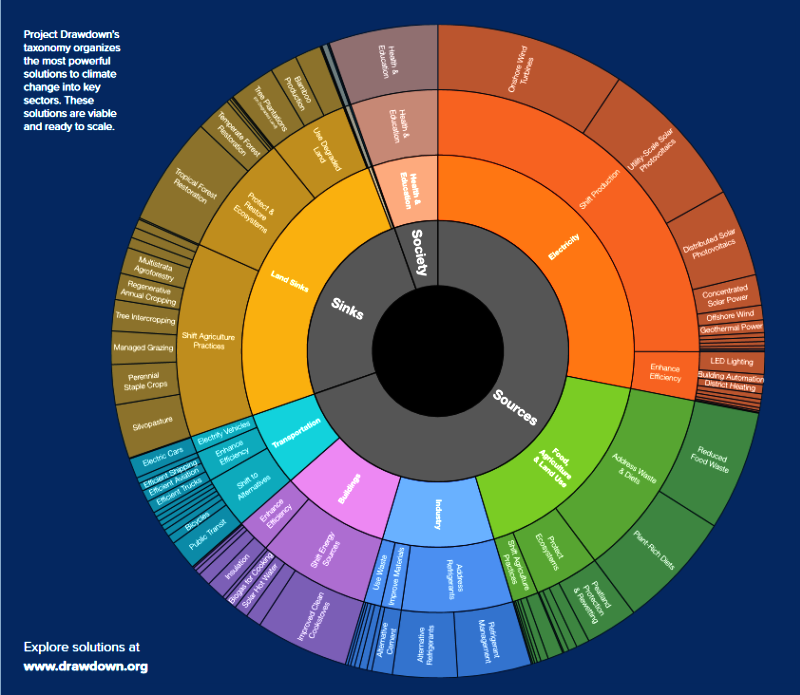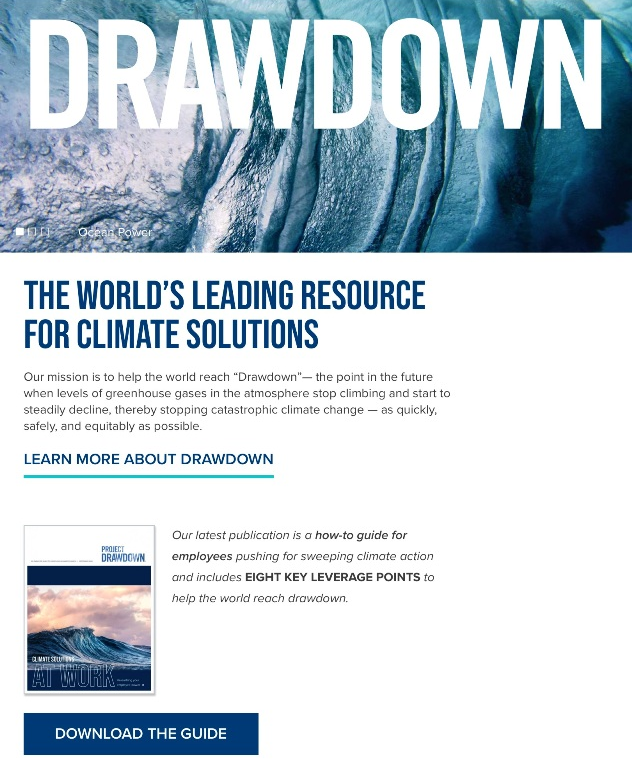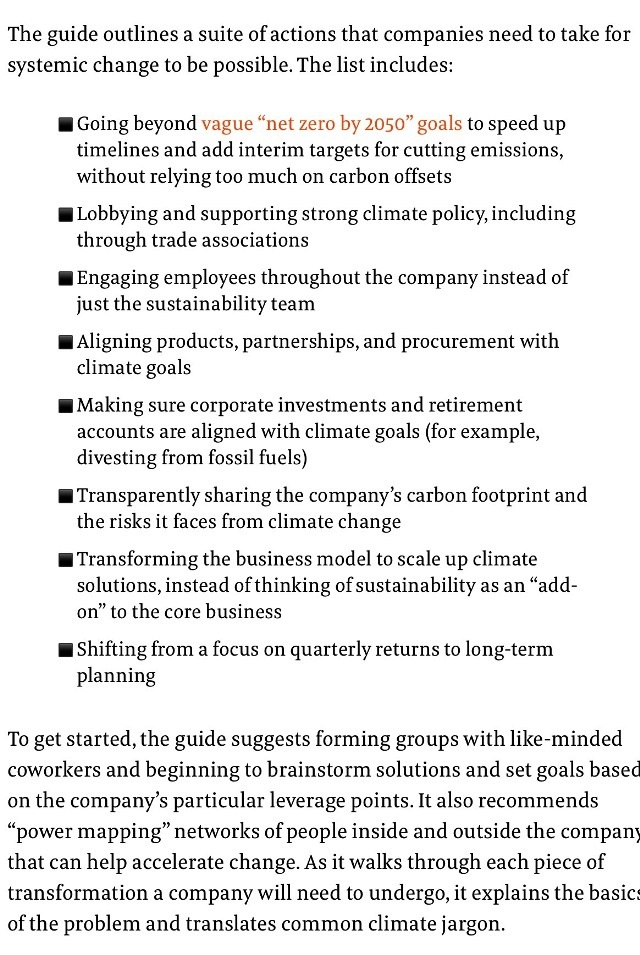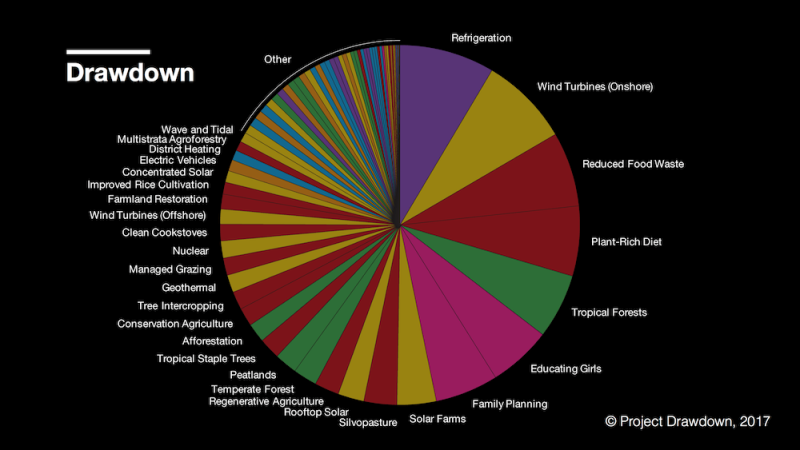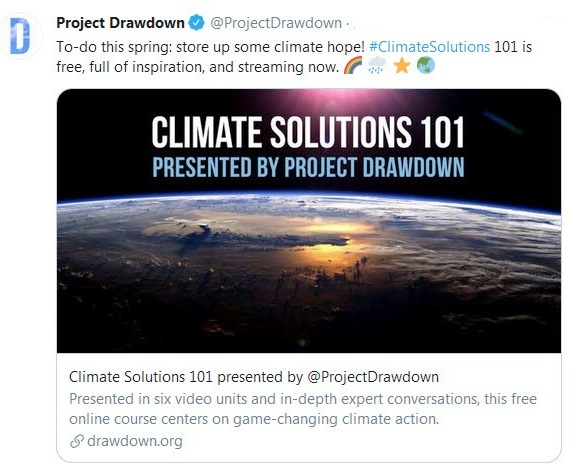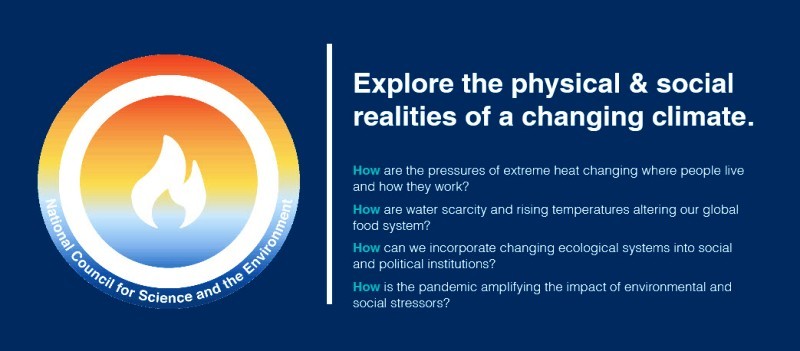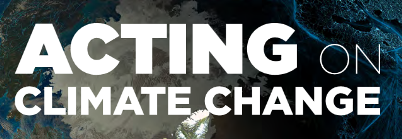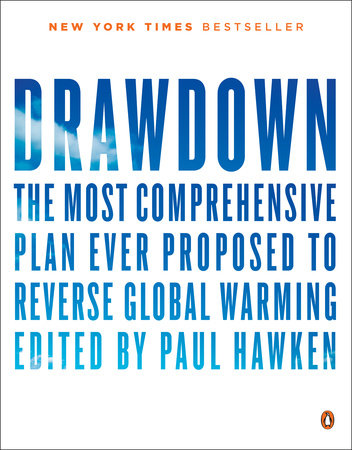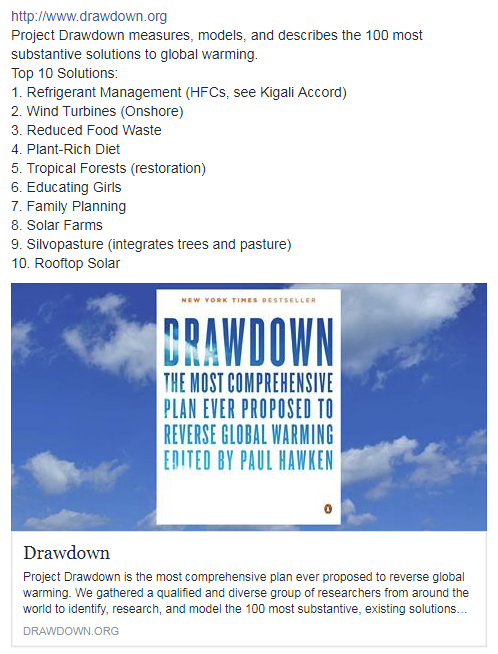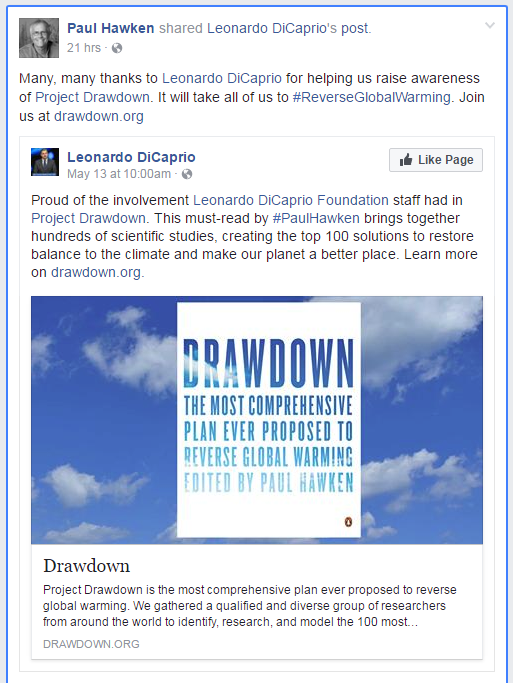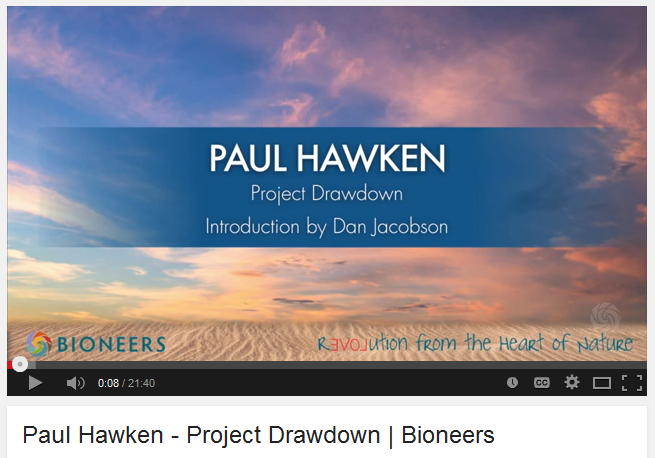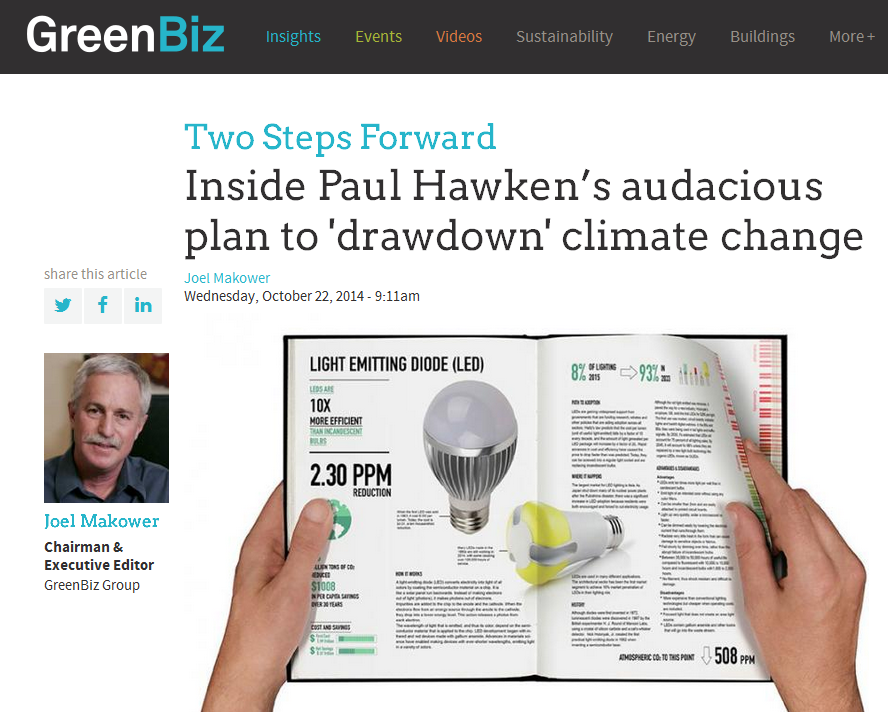ProjectDrawdownCO2: Difference between revisions
Siterunner (talk | contribs) No edit summary |
Siterunner (talk | contribs) No edit summary |
||
| (31 intermediate revisions by the same user not shown) | |||
| Line 2: | Line 2: | ||
<big>''''' | <big>'''2022'''</big> | ||
<big>'''On Earth Day, April 22'''</big> | |||
[[File:Drawdown Climate action, climate solutions.png]] | |||
:::: [[File:Drawdown - pushing climate action at work.png]] | |||
::: [[File:Drawdown - pushing climate action at work 2.png]] | |||
[[File:Drawdown Solution Chart.png]] | |||
<big><big><big>'''Practical Solutions to Reverse Global Warming'''</big></big></big> | |||
Systemic and Individual Changes, Problems & Solutions | |||
''"We have to identify the problem, then act in many ways to solve the problem. Global warming is the threat of our times."'' | |||
-- Jerry Brown, California Governor | |||
''"We’re going to need to use every tool in the toolbox if we’re going to solve this problem."'' | |||
-- Michael E. Mann | |||
<big>'''2021'''</big> | |||
[[File:Project Drawdown - Spring 2021.jpg]] | |||
:::<big>'''Project Drawdown'''</big> | |||
:::Solutions to Climate Change | |||
:::Watch the online video series | |||
:::Follow the story at [https://twitter.com/ProjectDrawdown @ProjectDrawdown] | |||
:::* https://drawdown.org/climate-solutions-101 | |||
:<font color=green>○ ○ ○ ○ ○ ○</font> <font color=blue>○ ○ ○ ○ ○ ○</font> <font color=green>○ ○ ○ ○ ○</font> <font color=blue>○ ○ ○ ○ ○ ○</font> <font color=green>○ ○ ○ ○ ○ ○</font> | |||
<big>'''2020'''</big> | |||
[[File:Science & Solutions - 2020 - Project Drawdown - NCSE.jpg]] | |||
[[File:Science & Solutions - 2020 - Project Drawdown - NCSE Conf.jpg]] | |||
<small>''JANUARY 5-9, 2021 | VIRTUAL CONFERENCE''</small> | |||
<big><big>'''''PROJECT DRAWDOWN + NCSE'''''</big></big> | |||
''Project Drawdown and the National Council for Science and the Environment (NCSE) brings together from across the globe to share and expand on the latest solutions to the world’s most pressing global challenges.'' | |||
''Through intentional virtual conference design, NCSE Drawdown 2021 will offer numerous opportunities for networking, collaborations, and actions for building a pathway to a future with a shared vision for sustainability and regeneration informed by an enduring foundation of science. | |||
Scheduled for 5 days, January 5-9, 2021.'' | |||
''The first half (January 5-7) of the Climate Science & Solutions conference will be facilitated by the National Council for Science and the Environment and will focus on the physical and social realities of climate change and the way this impacts people, ecosystems, markets, and the places people live.'' | |||
''The latter half (January 7-9) of the conference is facilitated by Project Drawdown with an objective to share the latest knowledge on climate solutions, and their effective communication and implementation to bring research to action.'' | |||
🌎 | |||
[[File:Acting on Climate Change.png]] | |||
<big>'''2020'''</big> | |||
<big>'''''How to combat global warming in 100 ways'''''</big> | |||
* https://www.scpr.org/programs/airtalk/2017/05/25/57006/how-to-combat-global-warming-in-100-ways/ | |||
<big>'''2019'''</big> | |||
[https://www.nyla.org/max/4DCGI/cms/review.html?Action=CMS_Document&DocID=2536&MenuKey=SI '''''Project Drawdown, book club resources/videos'''''] | |||
<big>'''2018'''</big> | |||
[https://m.youtube.com/watch?v=4rYRqzW2bh4&t=9s '''''Project Drawdown (podcast) -- Paul Hawken and Ralph Nader'''''] | |||
''Paul Hawken makes the case that global warming is reversible in his book “Drawdown.”'' | |||
<big>'''2017'''</big> | |||
| Line 9: | Line 118: | ||
'''Project Drawdown's Climate Book Is Published † | '''Project Drawdown's Climate Book Is Published † | ||
• http://www.penguinrandomhouse.com/books/549348/drawdown-by-edited-by-paul-hawken/9780143130444/ | |||
• http://www.drawdown.org/the-book | |||
• http://www.drawdown.org/ | |||
• http://www.drawdown.org/solutions/ | |||
: http://www.drawdown.org/solutions-summary-by-rank | :• http://www.drawdown.org/solutions-summary-by-rank | ||
• https://www.greenpolicy360.net/w/File:GreenBiz_Drawdown_story_cover.png | |||
Watch Paul Hawken's Drawdown Video, Seattle, Washington -- https://www.youtube.com/watch?v=0zaTGMl11hs | |||
:::[[File:Drawdown.jpg]] | :::[[File:Drawdown.jpg]] | ||
[[File:Drawdown top ten solutions - 2017.png]] | |||
<big>'''''Female empowerment is the most effective carbon mitigation strategy'''''</big> | |||
''It is family planning that enables women to have only children they want and choose, and education of girls, giving them access to income opportunities outside the home.'' | |||
''We know that women, given the resources and the choice, will opt for smaller families.'' | |||
''These are the two most powerful levers to bend [https://www.vox.com/energy-and-environment/2017/9/26/16356524/the-population-question the population curve]. They are also, in and of themselves, an enormously powerful climate policy.'' | |||
: '''''Family Planning''''' -- http://www.drawdown.org/solutions/women-and-girls/family-planning | |||
: '''''Education of Girls''''' -- http://www.drawdown.org/solutions/women-and-girls/educating-girls | |||
''Via David Roberts @Vox / Sept. 2017: When Paul Hawken and his team investigated and ranked carbon-reduction solutions for their Drawdown project, they found that the combination of the two (call it the female-empowerment package) carried the most potential to reduce greenhouse gases later this century, out of any solution. (Together they could prevent 120 gigatons of GHGs by 2050 — more than on- and offshore wind combined.)'' | |||
○ | |||
| Line 32: | Line 169: | ||
<font color=green>○ ○ ○ ○ ○ ○</font> <font color=blue>○ ○ ○ ○ ○ ○ ○</font> <font color=green>○ ○ ○ ○ ○</font> <font color=blue>○ ○ ○ ○ ○ ○ ○</font> | |||
| Line 101: | Line 238: | ||
'''Resources''' | '''Resources''' | ||
http://www.usgbc.org/articles/greenbuild-2014-opening-plenary-video | • http://www.usgbc.org/articles/greenbuild-2014-opening-plenary-video | ||
http://www.theguardian.com/sustainable-business/2014/oct/22/first-look-environmental-entrepreneur-paul-hawkens-long-awaited-new-book | • http://www.theguardian.com/sustainable-business/2014/oct/22/first-look-environmental-entrepreneur-paul-hawkens-long-awaited-new-book | ||
http://business.edf.org/blog/2014/12/09/it-cant-be-done/ | • http://business.edf.org/blog/2014/12/09/it-cant-be-done/ | ||
| Line 111: | Line 248: | ||
[[File:Project Drawdown Bioneers.png | link=https://www.youtube.com/watch?v=-tRdFX6IXUg]] | [[File:Project Drawdown Bioneers.png | link=https://www.youtube.com/watch?v=-tRdFX6IXUg]] | ||
| Line 120: | Line 258: | ||
🌎 | |||
[[Category:Anthropocene]] | |||
[[Category:Atmospheric Science]] | |||
[[Category:Bioneers]] | [[Category:Bioneers]] | ||
[[Category:Climate Change]] | [[Category:Climate Change]] | ||
[[Category:Climate Policy]] | [[Category:Climate Policy]] | ||
[[Category:Earth Science]] | |||
[[Category:Earth System Science]] | |||
[[Category:Ecology Studies]] | |||
[[Category:Energy]] | |||
[[Category:Environmental Protection]] | |||
[[Category:Environmental Security]] | |||
[[Category:Global Security]] | |||
[[Category:Global Warming]] | [[Category:Global Warming]] | ||
[[Category:Green Best Practices]] | [[Category:Green Best Practices]] | ||
[[Category:Green Business]] | [[Category:Green Business]] | ||
[[Category:Green Networking]] | |||
[[Category:GreenPolicy360]] | |||
[[Category:Green Politics]] | [[Category:Green Politics]] | ||
[[Category:Ocean Science]] | |||
[[Category:Planet Citizen]] | |||
[[Category:Planet Citizens]] | |||
[[Category:Planet Citizens, Planet Scientists]] | |||
[[Category:Renewable Energy]] | [[Category:Renewable Energy]] | ||
[[Category:Resilience]] | [[Category:Resilience]] | ||
[[Category:Sustainability Policies]] | [[Category:Sustainability Policies]] | ||
[[Category:Whole Earth]] | |||
[[Category:Youth]] | |||
Latest revision as of 11:31, 12 June 2022
2022
On Earth Day, April 22
Practical Solutions to Reverse Global Warming
Systemic and Individual Changes, Problems & Solutions
"We have to identify the problem, then act in many ways to solve the problem. Global warming is the threat of our times."
-- Jerry Brown, California Governor
"We’re going to need to use every tool in the toolbox if we’re going to solve this problem."
-- Michael E. Mann
2021
- Project Drawdown
- Solutions to Climate Change
- Watch the online video series
- Follow the story at @ProjectDrawdown
- ○ ○ ○ ○ ○ ○ ○ ○ ○ ○ ○ ○ ○ ○ ○ ○ ○ ○ ○ ○ ○ ○ ○ ○ ○ ○ ○ ○ ○
2020
JANUARY 5-9, 2021 | VIRTUAL CONFERENCE
PROJECT DRAWDOWN + NCSE
Project Drawdown and the National Council for Science and the Environment (NCSE) brings together from across the globe to share and expand on the latest solutions to the world’s most pressing global challenges.
Through intentional virtual conference design, NCSE Drawdown 2021 will offer numerous opportunities for networking, collaborations, and actions for building a pathway to a future with a shared vision for sustainability and regeneration informed by an enduring foundation of science.
Scheduled for 5 days, January 5-9, 2021.
The first half (January 5-7) of the Climate Science & Solutions conference will be facilitated by the National Council for Science and the Environment and will focus on the physical and social realities of climate change and the way this impacts people, ecosystems, markets, and the places people live.
The latter half (January 7-9) of the conference is facilitated by Project Drawdown with an objective to share the latest knowledge on climate solutions, and their effective communication and implementation to bring research to action.
🌎
2020
How to combat global warming in 100 ways
2019
Project Drawdown, book club resources/videos
2018
Project Drawdown (podcast) -- Paul Hawken and Ralph Nader
Paul Hawken makes the case that global warming is reversible in his book “Drawdown.”
2017
After Years in Development
Project Drawdown's Climate Book Is Published †
• http://www.penguinrandomhouse.com/books/549348/drawdown-by-edited-by-paul-hawken/9780143130444/
• http://www.drawdown.org/the-book
• http://www.drawdown.org/solutions/
• https://www.greenpolicy360.net/w/File:GreenBiz_Drawdown_story_cover.png
Watch Paul Hawken's Drawdown Video, Seattle, Washington -- https://www.youtube.com/watch?v=0zaTGMl11hs
Female empowerment is the most effective carbon mitigation strategy
It is family planning that enables women to have only children they want and choose, and education of girls, giving them access to income opportunities outside the home.
We know that women, given the resources and the choice, will opt for smaller families.
These are the two most powerful levers to bend the population curve. They are also, in and of themselves, an enormously powerful climate policy.
- Family Planning -- http://www.drawdown.org/solutions/women-and-girls/family-planning
- Education of Girls -- http://www.drawdown.org/solutions/women-and-girls/educating-girls
Via David Roberts @Vox / Sept. 2017: When Paul Hawken and his team investigated and ranked carbon-reduction solutions for their Drawdown project, they found that the combination of the two (call it the female-empowerment package) carried the most potential to reduce greenhouse gases later this century, out of any solution. (Together they could prevent 120 gigatons of GHGs by 2050 — more than on- and offshore wind combined.)
○
○ ○ ○ ○ ○ ○ ○ ○ ○ ○ ○ ○ ○ ○ ○ ○ ○ ○ ○ ○ ○ ○ ○ ○ ○
Q4 2014
Green Best Practices, Green Solutions, Green Practices @work
Project Drawdown -- Reviewed by GreenBiz
Paul Hawken on Twitter -- Project Drawdown on Twitter
○
Project Drawdown, founded by Paul Hawken, is a US-based organization developing a book, open-source database, and digital platform describing 100+ existing technological and social solutions to our climate crisis, and analyzing their potential financial and climate impact at-scale over the next thirty years. Through this effort we hope to present a roadmap toward drawdown, or the point at which greenhouse gases in our atmosphere reach their modern day peak and then begin to decline. Drawdown describes a comprehensive range of solutions that reduce carbon emissions, substitute existing technologies/practices with more efficient alternatives, or sequester carbon from the atmosphere. We are building robust solution-specific models designed to calculate the financial costs and savings of implementation, and the impact these solutions will have on carbon emissions and CO2 levels in the upper atmosphere by 2045. Our carefully vetted list represents “no regrets” initiatives, solutions that should be implemented whether or not the threat of climate change existed.
Co-developed by our coalition of scientists, scholars, policymakers, students, advocates and business leaders from across the globe, Drawdown represents the collaborative input of over 200 individuals and organizations worldwide. Our active and highly engaged group of Advisors has been described as "The Who's Who" of climate leaders, with five IPCC lead authors, including Dan Kammen, Peter Smith, and Karen O'Brien; luminaries like Bill McKibben, Janine Benyus, and Sir Jonathan Porritt; and many others.
○ ○ ○ ○ ○ ○ ○ ○ ○ ○ ○ ○ ○ ○ ○ ○ ○ ○ ○ ○ ○ ○ ○ ○
http://www.metropolismag.com/Q-A-Paul-Hawken/
Q&A: Paul Hawken
Paul Hawken: Drawdown refers to a point in time when there is a year-to-year reduction in greenhouse gases in the atmosphere. Project Drawdown is a book by the same name, a database, a basis for curricula, and a digital platform that describes how we can reduce carbon in the atmosphere using existing technologies, while measuring the beneficial financial and ecological impact they deliver over the next 30 years.
SV (Metropolitan Magazine): This is quite a multifarious project—where did it start?
PH: It began in my mind thirteen years ago with the Intergovernmental Panel on Climate Change’s third assessment report, entitled Climate Change 2001. After it was released, many articles were written enumerating the projected decline in the ice caps, a rise in sea levels and temperatures, and other data that gives scope and dimension to the impacts of climate change. I had become familiar with this topic in 1976 when working with Peter Schwartz at SRI International, formerly Stanford Research Institute, and, from that point until 2001, I had been tracking how climate change was being discussed and understood.
What I did not see in 2001 was an attempt to calibrate the tools and means that were in our hands to reduce and sequester carbon. This came up again in 2012 when Bill McKibben penned his now-famous “Global Warming’s Terrifying New Math” piece in Rolling Stone. Here was a list of impacts, far more potent and eloquent than what was expressed in 2001, about what was going to happen if we did not work to cap carbon emissions.
Once again, I wondered why no one had done the math on an array of solutions that reduce our energy use, change the sources of our energy to low-carbon, and biosequester carbon in farmlands, grasslands, and forest-lands. In 2001, the Carbon Mitigation Initiative at Princeton University listed fifteen “wedges” that could reduce carbon emissions by a billion tons per year. However, when I read the list, it had the opposite effect than what Drawdown is about—it made me pessimistic. Solutions included technologies that are not practiced, affordable, nor running, and mostly could be implemented only by large utility or energy companies. Individuals could install solar rooftops and drive less frequently, and that was it. What distinguishes Drawdown is that we show what can be done at the level of the individual, then neighborhoods and communities, and continue through buildings, facilities, utilities, businesses, towns, cities, farmlands, grasslands, forestlands, provinces, and states.
SV: From the long list of contributors, is it accurate to call it a crowdsourced project?
PH: I felt it was important that this be a book from “us” to “us.” It is generated by hundreds of qualified contributors, all of whom will receive author credit, and is peer-reviewed by a distinguished group of scientists, businesspeople, political leaders who are at the forefront of climate change policy, scholars, leaders in religion and civil society—activists such as May Boeve of 350.org, writers such as Elizabeth Kolbert of the New Yorker, members of parliament, and more. We want the data—both the facts and numerical analysis—to be impeccable in its accuracy, conservative in its assumptions, and comprehensive in its scope. The purpose of Drawdown is to reflect back to society what we know, what we are doing, and what is possible thirty years hence.
SV: The financial costs (and savings) to implement the carbon-reduction technologies are included in each of their descriptions. Why tackle economics?
PH: Climate deniers often cite the “cost” of climate mitigation as being too expensive and unaffordable. When you see that almost all solutions have a positive return, we can shift the idea from mitigation being a cost to being an investment. People will see that climate solutions transform the world, create jobs, and improve health and wellbeing. There isn’t one solution in Drawdown that we wouldn’t want to do, even if climate change was not an issue.
SV: What were some designs that nearly made the final cut but didn’t, and why?
PH: We thought water-saving technologies would have a significant impact on carbon emissions, but, when we did the calculations, that turned out not to be the case. I come from California, a state where 20 percent of the electricity is used to move water around, so it seemed a no-brainer. But that’s why we do the math.
SV: Much of what used to be considered “science fiction” seems to have served as a blueprint for designing new technologies. But plenty of design doesn’t do much that’s truly useful. Is there a lack of serious problem-solving in design today?
PH: Yes and no. We remain in an age where we design to sell, where the materials and overall impact of a product are measured in terms of dollar cost, but not the cost to the skies or the future. On the other hand, in the built environment, we are seeing brilliant and ingenious design in net-zero homes and the living-building movement. These exquisitely beautiful structures demonstrate that great design emerges from constraint, not license; design that does not externalize costs onto future generations is brilliant and beautiful.
SV: The “Coming Attractions” section of the book seemingly forecasts ways for technology to deal with our environmental mistakes. Are tech and design the answer?
PH: As soon as we complete Project Drawdown, we will start on a second volume entitled Drawdown 2. It will detail one hundred emergent solutions and technologies that have been validated scientifically and practically, but which are either incipient or not in the market yet. They include the impact that autonomous vehicles will have on total auto ownership, IP addressable lightbulbs, Dutch agricultural techniques that could feed nine billion people utilizing a space that’s one-quarter the land-area size of Holland, and printable solar and boron fusion reactors. Each of these will have a profound impact on reducing carbon emissions. Is tech the answer? Not as such. The answer is our thinking—what we believe, how we see the world. When that changes, everything changes, including technology.
SV: Will humanity survive climate change?
PH: We cannot demonize the world, whether it is people, or carbon, or governments, or corporations. It doesn’t mean that we don’t speak truth to power, but we have to ask ourselves this question because we caused this situation by our own actions: Did climate change happen to us or is it happening for us? If it is happening to us, then we are victims and we are cut off and separated from each other because somebody victimized us and did this to us. But, if it is happening for us, we are empowered and we see our current situation as a gift, not a curse.
Climate change is the thing that will transform everything. Nothing will be the same, except deeply held human values and sensibilities that come from being alive. The solutions that reside in nature surpass everything we think is possible and they are right in front of us waiting to be discovered, mimicked, and integrated into our ways of operating on this planet. We have just begun to scratch the surface. With climate change you can see it as, “Why was I born now?” Or, you can see it as, “This is such an extraordinary time to be alive.” The climate crisis will lead us to a better, smarter, safer, and kinder world for all species. My hope is that Project Drawdown will help lead us in this direction.
○
Resources
• http://www.usgbc.org/articles/greenbuild-2014-opening-plenary-video
• http://business.edf.org/blog/2014/12/09/it-cant-be-done/
🌎
- Anthropocene
- Atmospheric Science
- Bioneers
- Climate Change
- Climate Policy
- Earth Science
- Earth System Science
- Ecology Studies
- Energy
- Environmental Protection
- Environmental Security
- Global Security
- Global Warming
- Green Best Practices
- Green Business
- Green Networking
- GreenPolicy360
- Green Politics
- Ocean Science
- Planet Citizen
- Planet Citizens
- Planet Citizens, Planet Scientists
- Renewable Energy
- Resilience
- Sustainability Policies
- Whole Earth
- Youth
